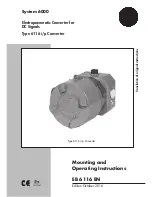
UMAX140610. LIN
– J1939 CAN Protocol Converter with PWM Output. Version 1
Page: 48-81
The
CAN Receive
function block reads single-frame application specific CAN messages and
extracts CAN signal data presented in user-defined data format. Different
CAN Receive
function blocks can read and process the same CAN message to extract different CAN signal
data.
The CAN messages transmitted by the converter itself are also processed by
CAN Receive
function blocks. The only difference in processing of the internal messages is that they are not
sampled from the CAN bus and therefore their processing does not depend on the state of the
bus.
Configuration parameters of the
CAN Receive
function block are presented below:
Table 30. CAN Receive Function Block Configuration Parameters
Name
Default Value
Range
Units
Description
Received
Signal Type
CAN Receive 1-
Continuous
Others - Undefined
{Undefined, Discrete,
Continuous}
–
J1939 Signal type
Receive
PGN
X
1
Any J1939 PGN
value
2
–
Signal message PGN value.
Enable
Specific
Address
False
{False, True}
–
Only CAN messages from the
selected address will be
accepted, if “Yes”.
Specific
Address
that sends
PGN
0
[0; 253]
–
Address of the ECU
transmitting CAN messages if
PGN From Selected Address
is set to “Yes”.
Received
message
Timeout
500
[0; 60000]
ms
Function block signal output
timeout value. If Autoreset
Time is 0, auto-reset is
disabled.
Received
Data Size
0
[1…32]
bit
CAN input signal size.
Received
Data Index
in Array
(LSB)
0
[0; 7]
–
Start byte of the CAN input
signal in the CAN message
data frame.
Received
Bit Index in
Byte (LSB)
0
[0; 7]
–
Start bit of the CAN input
signal in the Data Position
Byte.
Received
Data
Resolution
1
Any value
Signal
Units /
bit
CAN input signal resolution for
continuous input signals.
Received
Data Offset
0
Any value
Signal
Units
CAN input signal offset for
continuous input signals.
Received
Data Min
(Off
Threshold)
0
[-100000; 100000]
Signal
Units
The minimum value of the X-
axis used in the linear
calculations. As the name
imply, it is also used as the
OFF thresholds for digital input
types.
















































